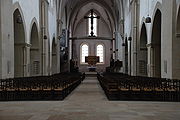
Loccum Abbey
Encyclopedia

Rehburg-Loccum
Rehburg-Loccum is a town 50 km north west of Hanover in the district of Nienburg in Lower Saxony, Germany.-Geographical location:Rehburg-Loccum borders the Steinhude Lake...
, Lower Saxony
Lower Saxony
Lower Saxony is a German state situated in north-western Germany and is second in area and fourth in population among the sixteen states of Germany...
, near Steinhude Lake
Steinhude Lake
The Steinhuder Meer or Lake Steinhude is a lake in Lower Saxony, Germany located northwest of Hanover. It is named after the nearby village of Steinhude. It has an area of about , making it the largest lake of northwestern Germany, but it is very shallow, with an average depth of only and a...
.
History

Volkenroda Abbey
Volkenroda Abbey is a former Cistercian monastery in the municipality of Körner in the Unstrut-Hainich district of Thuringia, Germany.-History:...
under the first abbot, Ekkehard, in 1163. An ancient account describes it as being "in loco horroris et vastæ solitudinis et prædonum et latronum commorationis" ("in a place of horror and a desert of solitude and a dwelling of thieves and brigands"); and adds that, after suffering much from want and from the barbarity of their neighbours, the monks in time brought the land into cultivation, and the people to the fear of God . Loccum very quickly grew wealthy and was under the direct protection of the Pope and the Emperor as an Imperial abbey (i.e., territorially independent).
In the 16th century in Protestant Reformation
Protestant Reformation
The Protestant Reformation was a 16th-century split within Western Christianity initiated by Martin Luther, John Calvin and other early Protestants. The efforts of the self-described "reformers", who objected to the doctrines, rituals and ecclesiastical structure of the Roman Catholic Church, led...
it became Lutheran. By 1700 the abbot of Loccum was permitted to marry and the Loccum Hof was built at Hanover to accommodate his spouse. The monastery retained its property and wealth until the agrarian reforms of the 19th century, when it was included in the territory of the Duchy of Braunschweig-Lüneburg
Brunswick-Lüneburg
The Duchy of Brunswick-Lüneburg , or more properly Duchy of Brunswick and Lüneburg, was an historical ducal state from the late Middle Ages until the late Early Modern era within the North-Western domains of the Holy Roman Empire of the German Nation, in what is now northern Germany...
, otherwise Hanover
Hanover
Hanover or Hannover, on the river Leine, is the capital of the federal state of Lower Saxony , Germany and was once by personal union the family seat of the Hanoverian Kings of Great Britain, under their title as the dukes of Brunswick-Lüneburg...
.
Since 1891 the monastery has also operated as a Protestant seminary and academy, a tradition going back to the turn of the 18th and 19th centuries. The title of "abbot
Abbot
The word abbot, meaning father, is a title given to the head of a monastery in various traditions, including Christianity. The office may also be given as an honorary title to a clergyman who is not actually the head of a monastery...
" is retained, anomalously.
Modern community
The community today generally consists of between four and eight members, most of whom are also in holy orders. In addition the Lutheran Bishop of Hanover and the Director of Studies of the seminary are members ex officio. The abbot and prior are chosen from among the members.Buildings
The abbey is known for its extremely well preserved monastic buildings from the late RomanesqueRomanesque architecture
Romanesque architecture is an architectural style of Medieval Europe characterised by semi-circular arches. There is no consensus for the beginning date of the Romanesque architecture, with proposals ranging from the 6th to the 10th century. It developed in the 12th century into the Gothic style,...
period with church, cloister and associated rooms, chapter-house, sacristy, dormitory, refectory, library and lay-brothers' wing, as well as the various service buildings. The buildings as a whole are considered of equal architectural worth with Maulbronn Abbey
Maulbronn Abbey
Maulbronn Monastery is the best-preserved medieval Cistercian monastery complex in Europe. It is situated on the outskirts of Maulbronn, Baden-Württemberg, Germany and is separated from the town by fortifications. Since 1993 the monastery is part of the Unesco World Heritage.- History :The...
and Bebenhausen Abbey
Bebenhausen Abbey
Bebenhausen Abbey was a Cistercian monastery located in the village of Bebenhausen , in Baden-Württemberg, Germany. It was built by Rudolf I, Count Palatine of Tübingen, probably in 1183....
. The monastery's ponds and woods also throw an interesting light on the abbey's medieval economy.
The abbey church of Saints Mary and George
Saint George
Saint George was, according to tradition, a Roman soldier from Syria Palaestina and a priest in the Guard of Diocletian, who is venerated as a Christian martyr. In hagiography Saint George is one of the most venerated saints in the Catholic , Anglican, Eastern Orthodox, and the Oriental Orthodox...
- now St. George's parish church - was probably built between 1230/40 to 1280.
Recent abbots
- Gerhard Wolter MolanusGerhard Wolter MolanusGerhard Wolter Molanus was Lutheran theologian and abbot of Loccum....
(1677–1722)
---
- Gerhard Uhlborn (1871 - 1901?)
- Georg Hartwig (? - 1927)
- August Marahrens (1927–1950)
- Johannes Lilje (1950–1977)
- Eduard Lohse (1977–2000)
- Horst Hirschler (from 2000)

